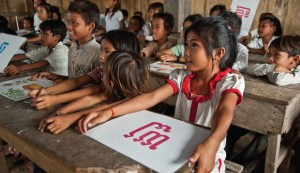Did you know that Cambodia has a literacy rate of 74 percent? That is considered one of the lowest rates in Asia. Literacy rates are used to determine education quality in each country. However, the primary education completion rate in 2009 was 84 percent and has been slowly increasing. The literacy rate is fairly low for the rate of completion  of primary education in Cambodia; meaning more children are going to school, but the literacy rate is almost stagnant. According to the World Bank, 25 to 50 percent of students that have graduated from primary school cannot not read at all. 250 million children are still unable to read and write. Although the number of students enrolling in school is increasing, there seems to be no effectiveness. So once again, how do you go about improving the educational levels in a country?
of primary education in Cambodia; meaning more children are going to school, but the literacy rate is almost stagnant. According to the World Bank, 25 to 50 percent of students that have graduated from primary school cannot not read at all. 250 million children are still unable to read and write. Although the number of students enrolling in school is increasing, there seems to be no effectiveness. So once again, how do you go about improving the educational levels in a country?
After taking my economic development class last semester, I realized the importance of education. Education is the base of everything. Education is a good means of acquiring skills, knowledge, and motivation to work. Education increases people’s knowledge, or in economic terms we call it an accumulation of human capital. In economic development, this increase in human capital increases income per person. It has been proven in many studies that education directly improves people’s standard of living by increasing the capacity to obtain a job. It also increases productivity and innovative capacity which reflects upon the country’s gross domestic product (GDP).
But how do you go about improving the education levels in a country? One of the Millennium Development Goals by the United Nation is to achieve Universal Primary Education by the year 2015. This goal is to insure completion of primary education for all children around the world. However, this goal is far from being attained .
Lets compare statistics from Cambodia’s education and Singapores. Singapore has one of the highest literacy rates of 96 percent in Southeast Asia. The expenditure per person as a percentage of GDP per capita in Singapore is 12 percent, whereas in Cambodia it is 6.8 percent. This shows that one of the reasons why Singapore has better education might be because of the amount of spending. Maybe it is spending on education that Cambodia needs to invest in.
However, just because you invest money on something does not mean it will show effectiveness. The keys are quality and accessibility of education. Cambodia is known for its high rates of poverty in rural areas. In these areas, the accessibility of education is very low and the number of dropouts are fairly high as well. Most of these problems  are due to the weakness and lack of quality in the educational system. There is obviously something lacking if the majority of Cambodian children are going to school, but they still cannot read or write. There seems to be a lack of guidance from the government and schools on how to improve the education system.
are due to the weakness and lack of quality in the educational system. There is obviously something lacking if the majority of Cambodian children are going to school, but they still cannot read or write. There seems to be a lack of guidance from the government and schools on how to improve the education system.
This is what I think can be done to address this. I think we should improve the teacher’s teaching capacity. What I mean by teaching capacity is the ability for the instructor to effectively teach desired skills to the students. Teachers should be able to engage their students in learning and teach them basic skills in primary schools. Even from my own experience, the quality of the teacher greatly impacts how well the students will do in school. When trying to increase the capacity of the teachers, I think that it is important for the teachers to be able to teach their students skills that will translate into economic growth. Some examples would be mathematic skills and creativity. In Cambodia’s case, one of the most important skills teachers should be able to teach is reading and writing by expanding the children’s vocabulary, spelling, and grammar.
Although the quantity of schools is also an important component for educational growth, in Cambodia’s situation, policies need to focus more on the quality of the schools. School attainment is only effective if the knowledge and skills of the students increase. It is important to focus on how much the students have learned as to how many years students have attained education. It will be an ideal situation if the increase in education quality translates into economic development.
What do you think Cambodia should do to increase their literacy rate and accessibility of schools? Please feel free to voice your opinions.


